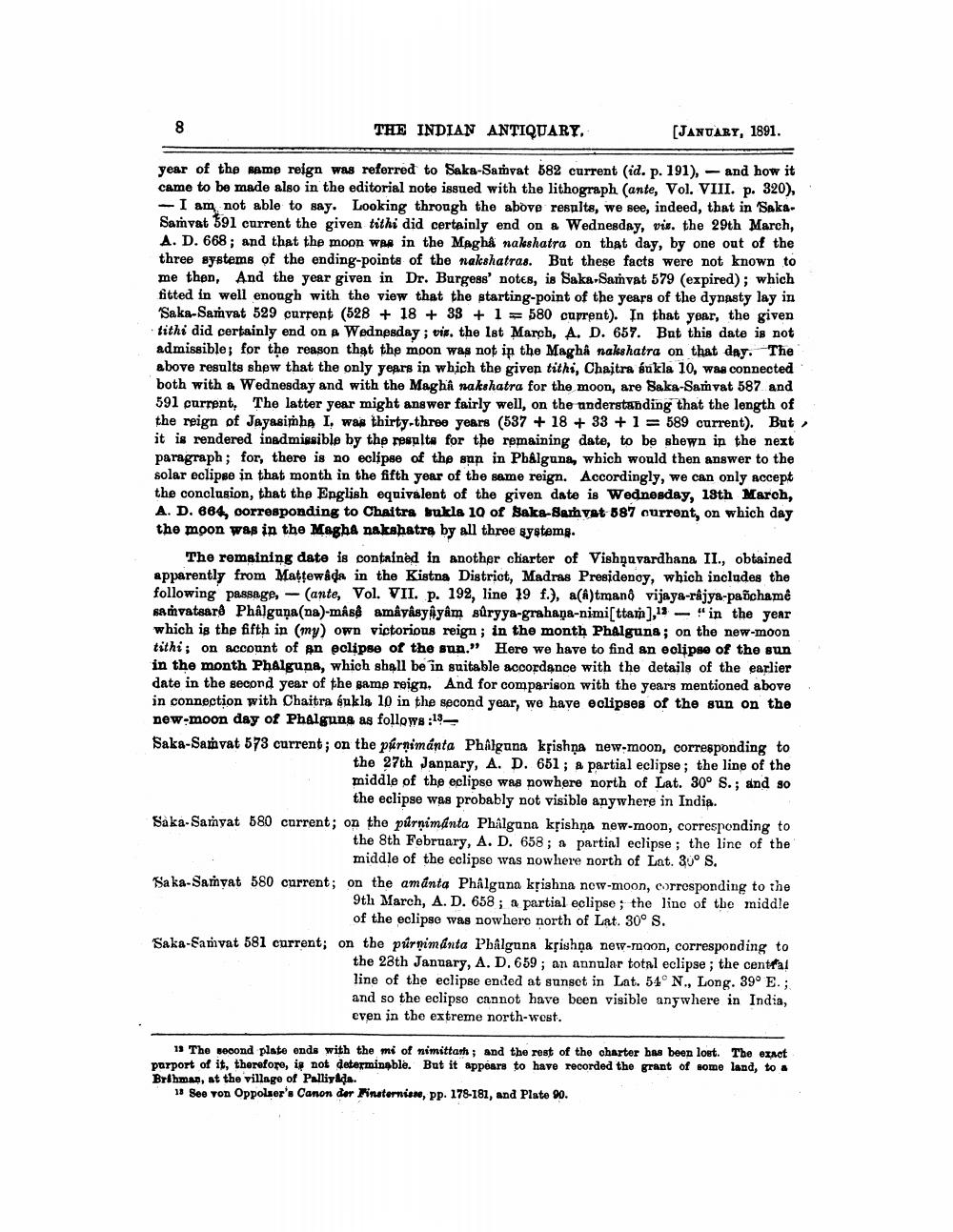________________
THE INDIAN ANTIQUARY.
(JANUARY, 1891.
year of the same reign was referred to Saka-Samyat 582 current (id. p. 191), - and how it came to be made also in the editorial note issued with the lithograph (ante, Vol. VIII. p. 320), - I am not able to say. Looking through the above results, we see, indeed, that in 'SakaSamvat 591 current the given tithi did certainly end on a Wednesday, vis. the 29th March, A. D. 668; and that the moon was in the Maghê nakshatra on that day, by one out of the three systems of the ending-points of the nakshatras. But these facts were not known to me then, And the year given in Dr. Burgess' notes, is Saka-Samvat 579 (expired); which fitted in well enough with the view that the starting-point of the years of the dynasty lay in Saka-Samvat 529 current (528 + 18 + 39 + 1 = 580 cuprent). In that year, the given tithi did certainly end on Wednesday; vis, the 1st March, A. D. 657. But this date is not admissible; for the reason that the moon was not in the Maghå nakshatra on that day. The above results shew that the only years in which the given tithi, Chaitra sukla 10, was connected both with a Wednesday and with the Maghî nakshatra for the moon, are Baka-Samvat 587 and 591 current. The latter year might answer fairly well, on the understanding that the length of the reign of Jayasimha I, was thirty-three years (537 + 18 + 33 + 1 = 589 current). But it is rendered inadmissible by the results for the remaining date, to be shewn in the next paragraph; for, there is no eclipse of the sun in Pbalguns, which would then answer to the solar eclipse in that month in the fifth year of the same reign. Accordingly, we can only accept the conclusion, that the English equivalent of the given date is Wednesday, 18th March, A. D. 664, corresponding to Chaitra bukla 10 of Saka-Sarhvat 587 current, on which day the moon was in the Magha nakshatra by all three systems.
The remaining date is contained in another charter of Vishịuvardhana II., obtained apparently from Mattewada in the Kistna District, Madras Presidenoy, which includes the following passage, - (ante, Vol. VII. p. 192, line 19 f.), a(A)tmanó vijaya-rajya-paõchame samvatsarð Phalguna(na)-masa amâyâsyhyâm súryya-grahaņa-nimi[ttam),13 - " in the year which is the fifth in (my) own victorious reign ; in the month PhAlguns; on the new-moon tithi; on account of an polipse of the sun." Here we have to find an eclipse of the sun in the month Phalguna, which shall be in suitable accordance with the details of the earlier date in the second year of the same reign. And for comparison with the years mentioned above in connection with Chaitra sukla 10 in the second year, we have eclipses of the sun on the new moon day of Phalguna as follows:13 Saka-Samvat 573 current; on the purnimanta Phalguna krishna new-moon, corresponding to
the 27th Jannary, A. D. 651; a partial eclipse; the line of the middle of the eclipse was nowhere north of Lat. 30° S.; and so
the eclipse was probably not visible anywhere in India. Saka-Samyat 580 current; on the párnimánta Phâlguna kțishņa new-moon, corresponding to
the 8th February, A. D. 658; a partinl eclipse; the line of the
middle of the eclipse was nowhere north of Lat. 30° S. Saka-Samyat 580 current; on the amanta Phâlguna kțishna new-moon, corresponding to the
9th March, A. D. 658; a partial eclipse ; the line of the middle
of the eclipse was nowhere north of Lat. 30° S. Saka-Samvat 581 current; on the púrnimanta Pbalguna kşishņa new-moon, corresponding to
the 28th January, A. D. 659; an annular total eclipse; the central line of the eclipse ended at sunset in Lat. 54° N., Long. 39o E.; and so the eclipso cannot have been visible anywhere in India, even in the extreme north-west.
13 The second plato onds with the mi of nimittanh; and the rest of the charter bas been lost. The exact parport of it, therefore, ip not determinable. But it appears to have recorded the grant of some land, to a Brihman, at the village of Palliyada.
11 Seo von Oppolser's Canon der Minsternis, pp. 178-181, and Plate 90.




